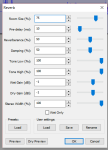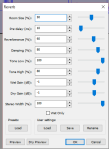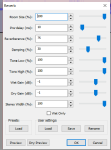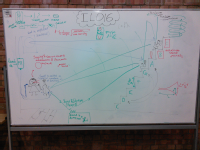Science of Music Sessions
This is the page from the 2015-16 course: this academic year the topics will change slightly, so this gives you an idea of the sort of things we'll cover.
This (rather long!) page has material and reflections on each of the taught sessions. You should use it for revision and reinforcement and will probably need material from here to help with the Moodle multiple-choice exercises.
Session 1 - Introduction and Students' Clips
Slides from the first session.
Session 2 - Fundamentals of sound
Some useful animations.
Some extra notes from the session including the spectrograms we recorded; the original handout is here.
The sound files we recorded (zipped up).
An Excel file reinforcing what we discussed about loudness and the decibel scale.
FYI, the MATLAB code for the simple synthesis.
This is a simple table of Western equal temperament notes and their frequencies. You would be given this information in an exam.
- Could you describe the sound of a couple of different instruments using the concepts we discussed?
- Could you explain qualitatively, quantitatively if possible, the basic physical concepts discussed?
- Could you discuss an "unseen" spectrogram in terms of what a given instrument might be doing?
- Could you do a basic calculation on loudness?
Session 3 - Scales and tuning
There are several ways to think about how real sounds are built up from "simple" sounds, i.e. sine waves each with a single frequency. In session 2 we looked at the implications of Fourier's ideas, that a steady sound can be made out of a set of sine waves with frequencies f, 2f, 3f and so on, and no others. Mixing in frquencies which are not a simple multiple of the fundamental (anharmonics) was quite obvious to the ear. In music, we (usually!) want to play sounds with different values of f; sounds with well defined fundamental frequencies in relation to each other are called notes. So in session 3 we looked at how different notes are related by frequency. The key frequency relationships are the octave and the fifth (2f and [3/2]f). Combining notes of different "allowed" frequencies makes a scale. We usually give the notes in the scale names such as fifth, major third, minor third and so on.
Reading: MT chapters 1 and 2. There is a lot of interesting material in these two e-books (read via Library).
- The Physics and Psychophysics of Music, e.g. chapter 5 on the scales.
- Tuning, Timbre, Spectrum, Scale, e.g. chapters 1-4 building up to a nice discussion of scales.
Paul discussed some of the historical development of scales. The handout is here. The Pythagorean scale is of particular importance, being built only on fifths and octaves. Pachelbel's Canon in 3 tunings. More youtube: Equal temperament vs. Just temperament; useful and worth a critique.
Richard demonstrated mathematically that there is no way a scale can be built with a finite number of notes which allows us to keep octaves and fifths perfectly in tune. Here is the proof. It's not mere physics which stops us, it's logic!
Reflection:
- Can you discuss the physical reasons behind the importance of the fifth and octave?
- Do you understand the key points about vibrating strings? Make sure you understand the tension-length-density relationship.We'll cover vibrating air columns later but the basic ideas are similar.
- Can you describe Pythagoran tuning and discuss its "strengths and weaknesses"? What is the wolf fifth?
- Can you describe the later scales leading to Just Intonation? What is the difference to Equal Temperament?
- What is the role of beating in this discussion?
- Could you draw or tabulate some suitable representation of "stacks" of octaves (e.g. "circle of fifths", the spiral shown by Malik in session 4, the various wiki diagrams)?
Session 4 - Perception of Music
Notes from the session. Some sound illusions (try with headphones).
One important point to take away from the session - highlighted by the sound illusions - is that what we hear is strongly influenced by our expectations and the psychological interpretation mechanisms of the brain... our "software" as well as our "hardware". For example, in session 6 Jo and Rudo raised the question of how a single singer can be heard among a 100-piece orchestra. The "hardware" answer includes the singing formant which lies above the lower-frequency peak of the orchestra and in the peak sensitivity range of the human ear. But the "software" answer must surely include our increased attentiveness on the singer, centre-stage, well-lit and hamming it up diva-style!
Here are some complementary detailed notes. And here are some notes (well referenced!) from the audiophile point of view on sound perception.
Session 5 - Acoustic Instruments
Here are the notes. Most of the behaviour of acoustic instruments can be explained by waves on strings, standing waves in pipes (both open and closed – a ‘closed’ pipe is one that is open only at one end), transverse waves in solid bodies, or vibrations of membranes. Acoustic impedance matching is important when sound travels between bodies of different pressure and/or density – this is especially relevant when explaining the role of the flare of brass instruments. Further reading on this topic can be found in Appendix 6 of MT. This site has useful information on the working of the piano. You can also try the ‘action puzzle’ to test your knowledge of the playing mechanism.
The materials used in acoustic instruments were discussed, and Bruno Guastalla from Oxford Violins expanded on the role of spruce in violin making, as well as that of asymmetry.
- Can you show how harmonics on a string instrument are created?
- Can you calculate the fundamental frequency produced by open and closed pipes of a fixed length, and explain why they are an octave apart?
- Can you explain why idiophones such glockenspiels and triangles sound so inharmonic?
Session 6 - The Human Voice
The powerpoint slides are here. This 6MB zip file contains the spectrograms and frequency plots for Jo's singing, as well as the sound files. The tones are quite steady in time so the spectrograms mainly look like horizontal lines - but note the "wobble" on many of them with a frequency of about 8 Hz. What are these wobbles due to? I have also included frequency plots - here we throw away the time domain information and look at the overall frequency content of the whole clip. What features do you see in relation to the ideas Rudo discussed in the session?
We thought about the question of how a single singer can be heard above a large ensemble. Part of the answer is the ability of trained singers to produce high volumes! For the perceptual part of the answer I added some notes to Session 4 above.
Session 7 - Music in the Environment
The notes are here.
You may need to use Rachel's Excel spreadsheet to calculate reverb times. The inputs are just wall and floor areas along with their absorption coefficients, plus the number of people in the room. Several sites have some detailed tables of absorption coefficients. I have produced my own simple table (in an exam you would be given this data of course). Remember that absorption coefficient varies with frequency.
We recorded the Quartet playing with curtains open and shut in the Studio. I will upload the audio and some commentary as soon as I can get it processed.
I had also recorded a short clip to illustrate artifical reverb, using Audacity's simple default reverb. You might like to look up or experiment with how the "Room Size", "Reverberance" and "Damping" controls work.
Session 8 - Electronic Music
We discussed a few topics around electronic music, but by no means covered any in great detail. In particular digital signal processing is a huge and complex subject. You only need to know the basics at the level we went into in lecture segment.
The notes are here. They include all the relevant links to sound clips and other supporting material.
Session 9 - Revision and Reflections
The main topics of this session were reflecting on the Yorkston-Thorne-Khan / Laura Moody concert (inlcuding the Sarangi and Nyckelharpa instruments), thinking about 2D oscillators (with a MATLAB demo and Chaldni plates physical demo), and trying a sample exam question.
Material: the session notes, the Laura Moody sound files used in the quiz (or view on youtube), and if you're interested the MATLAB files needed to simulate oscillations of a circular membrane (e.g. drumskin).
We also thought about the Metal Umlaut!
Your course summary sketch:




